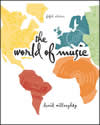Chapter 1 Introducing the World of Music Preparing to listen perceptively to this globally diverse and culturally rich art form The goal of this chapter is to demonstrate the diversity that exists in music, particularly in the context of American society; it can be fulfilled in many ways. The collage of musical styles, drawn from musical examples included in later chapters, can be a starting point. Many other musical examples from other parts of the book or from any source can be used to generate an awareness of the contrasting styles of music that exist in our society and in our world. The goal for listening is to experience the infinite variety of music by listening to and discussing brief excerpts of many different styles. The Infinite Variety of Music: A Global Perspective - Relationship to contemporary society; awareness of music from world cultures. Awareness of diversity of musical styles in the United States. Blending of cultures and traditions.
- Defining American music. Reasons for studying American music.
The American Mainstream and Ethnic Diversity - Mainstream: predominant culture: English (Anglo-Saxon). Defining America’s politics, religion, and language. Assimilation or isolation—complete or partial.
- Ethnic minorities who retained language, customs, or social values of original culture. Ethnic diversity—variety of immigrant groups that retained songs, dances, and instruments, as well as language, fashion, food, and life-styles; merging of cultural traditions.
- Musical mainstream—Western European traditions. Early religious, folk, and popular songs derived from or similar to songs from the British Isles and mainland Europe. Popularity and success of immigrant or visiting European artists and musicians. European-Americans rejecting the music of the Native Americans. Most of America’s popular and classical music based on the melodic, harmonic, and rhythmic practice of Western Europe.
Music in Culture—the Ethnomusicologists - Social Aspects. Who creates? Who performs and in what contexts? Who listens—formal or informal contexts.
- Musical Aspects. Common musical style. How music is taught and learned. Tangible aspects (instruments, equipment, etc.).
- Acculturation—the extent that music is affected by outside influences.
Labels—a multitude of problems associated with classifying or categorizing this infinite variety of music. Artists and Artistry—a discussion of these two words that have multiple meanings in our culture. Goals for Listening - Respond to diverse styles. Identify musical preferences. Look for patterns in pulse and meter.
- Describe qualities of musical tones. Identify levels of musical restlessness and calm.
|



 2003 McGraw-Hill Higher Education
2003 McGraw-Hill Higher Education